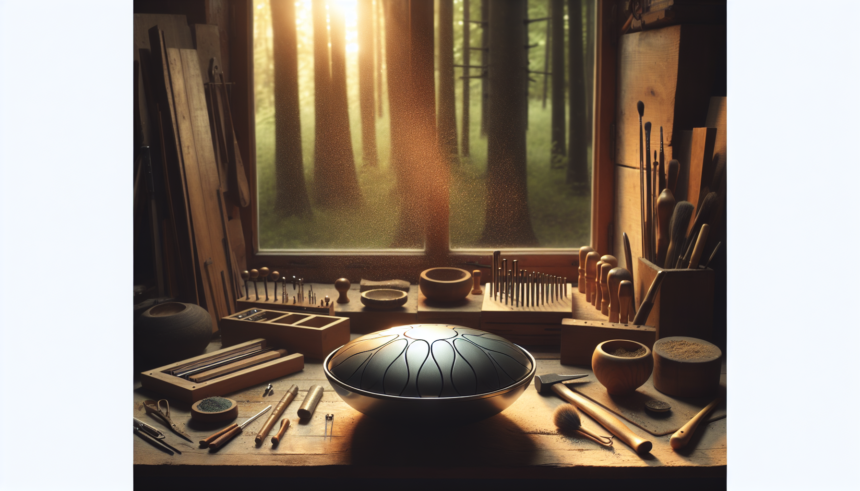Crafting Clarity: How Damping Enhances Handpan Performance
The handpan is a unique and captivating instrument, renowned for its resonant and ethereal sound. It is a relatively new addition to the world of percussion instruments, having been developed in the early 2000s. Its distinctive sound has made it popular in various genres of music, including ambient, world, and even modern classical compositions. However, one of the key aspects of mastering handpan performance lies in understanding and effectively utilizing damping techniques.
Damping, in the context of musical instruments, refers to the process of reducing the vibration of the instrument’s surface to control the duration and intensity of notes. For handpan players, this technique is vital in achieving clarity, precision, and expression in their music. In this article, we will delve into the importance of damping in handpan performance and explore how it can elevate a musician’s artistry.
The Role of Damping in Handpan Performance
Handpans produce sound through vibrations created by striking or tapping the metal surface. Each note on the handpan corresponds to a specific area or ‘tone field’ on the instrument. When a tone field is struck, it vibrates, producing a note with a certain pitch and sustain. While the natural resonance of the handpan is one of its most appealing features, uncontrolled sustain can lead to a muddy or chaotic sound.
This is where damping comes in. By intentionally stopping or reducing the vibration of certain tone fields, players can control the duration and clarity of each note. Effective damping ensures that the handpan produces clean, articulate sounds that do not interfere with subsequent notes. This clarity is essential for creating intricate melodies and rhythms, especially in fast-paced or complex compositions.
Types of Damping Techniques
There are several damping techniques that handpan players can use to enhance their performance. Each technique offers different levels of control and expression, allowing musicians to tailor their sound to fit their artistic vision. Here are some of the most common damping methods:
1. Finger Damping
Finger damping involves using the fingers or parts of the hand to lightly touch a tone field immediately after striking it. This technique quickly stops the vibration, resulting in a short and precise note. Finger damping is particularly useful for playing fast, staccato passages and intricate rhythmic patterns.
2. Palm Damping
Palm damping is a technique where the player uses the palm of their hand to mute the sound of the handpan. This method produces a softer and more subtle damping effect compared to finger damping. Palm damping can be used to create dynamic contrast in a performance, allowing for expressive crescendos and decrescendos.
3. Arm and Body Damping
Some players utilize their forearms, elbows, or even upper body to dampen the handpan. This approach provides an extensive muting effect, which is excellent for creating pauses or breaks in the music. Arm and body damping can also contribute to a more physical and visually engaging performance.
4. Sequential Damping
Sequential damping, also known as ‘ghosting,’ involves gradually reducing the sustain of a note over time. This technique can be achieved by lightly touching a tone field and slowly increasing the pressure until the sound fades out. Sequential damping adds a sense of fluidity and movement to the music, enhancing the emotional impact of a performance.
Benefits of Mastering Damping Techniques
Mastering damping techniques on the handpan offers several benefits that go beyond mere sound control. Here are some of the key advantages:
1. Enhanced Musical Expression
Damping allows players to precisely control the duration, intensity, and texture of each note. This capability opens up a vast range of expressive possibilities, enabling musicians to convey a wide array of emotions and moods through their performance. Whether creating delicate, whispering tones or powerful, percussive accents, damping techniques provide the tools needed to craft a rich and dynamic musical narrative.
2. Improved Articulation
Clear articulation is essential for playing intricate melodies and rhythms accurately. Damping techniques help prevent notes from overlapping and muddying the sound. By mastering these techniques, players can achieve crisp and precise articulation, ensuring that each note stands out distinctly in the context of the music.
3. Greater Control Over Dynamics
Damping provides a means to control the volume and intensity of each note. This control is crucial for creating dynamic contrast within a performance, allowing for smooth transitions between loud and soft passages. Effective use of dynamics adds depth and dimension to the music, making it more engaging and captivating for listeners.
4. Versatility in Musical Styles
The ability to manipulate sustain and resonance through damping expands the range of musical styles that can be effectively performed on the handpan. From minimalist ambient soundscapes to complex rhythmic compositions, damping techniques enable players to adapt their approach to suit various genres and performance contexts. This versatility enhances the handpan’s appeal as a sophisticated and adaptable instrument.
Practice Tips for Developing Damping Skills
Like any musical technique, mastering damping on the handpan requires dedicated practice and experimentation. Here are some tips to help players develop their damping skills:
1. Start with Basic Exercises
Begin by practicing simple damping exercises. For example, strike a tone field and immediately dampen it with your finger or palm. Focus on producing clean and consistent results. Gradually increase the complexity of the exercises, incorporating different damping techniques and combinations.
2. Incorporate Damping into Scales and Arpeggios
Practice scales, arpeggios, and other basic musical patterns while incorporating damping techniques. This approach helps integrate damping into your fundamental playing skills and builds muscle memory. Pay attention to the clarity and articulation of each note.
3. Explore Different Rhythmic Patterns
Experiment with applying damping in various rhythmic contexts. Practice playing different rhythmic patterns and motifs while using damping techniques to control the sustain and resonance of each note. This practice will enhance your ability to execute complex rhythms with precision.
4. Record and Analyze Your Playing
Recording your practice sessions and performances can provide valuable feedback. Listen back to the recordings and analyze the effectiveness of your damping techniques. Take note of areas where you can improve clarity, articulation, and dynamic control.
Conclusion
In conclusion, damping is a crucial technique that significantly enhances handpan performance by providing control over the instrument’s resonance, sustain, and articulation. Mastering damping allows handpan players to achieve greater musical expression, improved clarity, and dynamic versatility in their performances. By exploring and practicing various damping techniques, musicians can elevate their artistry and create captivating and emotionally resonant music. As players continue to experiment and refine their damping skills, the handpan will undoubtedly continue to enchant audiences with its unique and mesmerizing sound.
Frequently Asked Questions (FAQs)
1. What is the primary purpose of damping on the handpan?
The primary purpose of damping on the handpan is to control the duration and clarity of each note by reducing the vibration of the instrument’s surface. This helps prevent overlapping of notes and ensures clear articulation and expression in the music.
2. Can damping techniques be used in all genres of handpan music?
Yes, damping techniques can be applied across various genres of handpan music. Whether playing ambient soundscapes, rhythmic compositions, or melodic pieces, effective use of damping enhances clarity, dynamics, and overall musical expression.
3. Are there specific damping techniques for different types of handpans?
While the basic principles of damping apply to all handpans, the specific techniques may vary based on the design and characteristics of the handpan. Players should experiment with different methods to find what works best for their particular instrument and playing style.
4. How can I practice damping techniques effectively?
Effective practice involves starting with basic exercises, incorporating damping into scales and arpeggios, exploring different rhythmic patterns, and recording and analyzing your playing. Consistent and focused practice helps build muscle memory and refine your damping skills.
5. Is damping essential for all handpan performances?
While not every handpan performance may require extensive use of damping, mastering the techniques provides players with valuable tools for enhancing their music. Whether subtle or pronounced, damping adds depth and precision to a performance, making it a valuable skill for any handpan player.





